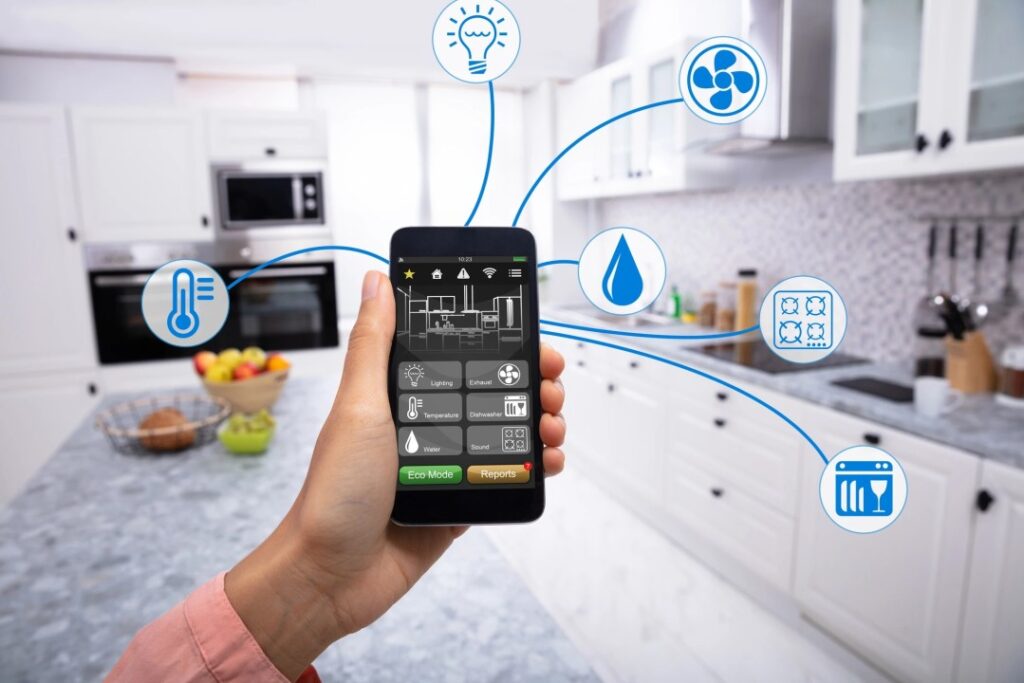The evolution of smart kitchen technology has redefined how we approach cooking, cleaning, and managing resources. By incorporating smart devices and appliances, you can reduce daily effort, save money on utilities, and optimize resources like food and water. This guide explores the ways smart kitchens deliver efficiency and cost savings while enhancing convenience.
The Role of Smart Technology in Modern Kitchens
Smart kitchens integrate advanced technologies such as IoT (Internet of Things), AI (Artificial Intelligence), and automation. Devices communicate seamlessly, performing tasks efficiently without constant human intervention. From refrigerators that track groceries to ovens that self-adjust cooking times, these innovations simplify chores while lowering utility expenses.
Saving Time with Smart Kitchens
1. Automating Routine Tasks
Smart devices streamline repetitive chores. For instance, smart dishwashers can schedule washing cycles overnight, while smart coffee makers prepare your morning brew at a set time.
2. Guided Cooking Assistance
Smart ovens and stoves come with recipe integrations and sensors that adjust cooking times and temperatures automatically. These features eliminate guesswork, reducing meal preparation times and preventing overcooking.
3. Voice Commands for Multitasking
Voice assistants like Alexa and Google Assistant enable hands-free control of kitchen appliances. You can preheat the oven, start timers, or reorder supplies without interrupting your workflow.
4. Real-Time Monitoring
Smart appliances allow remote monitoring through smartphone apps. Whether you’re at work or running errands, you can check your refrigerator’s inventory, stop a dishwasher cycle, or adjust oven temperatures in real-time.
Cutting Costs in the Kitchen
1. Energy Efficiency
Smart appliances are designed to optimize energy usage:
- Smart Refrigerators: These devices regulate cooling efficiently, preventing energy waste.
- Energy-Saving Dishwashers: Smart dishwashers analyze load sizes and adjust water usage accordingly.
- Lighting Systems: Smart LED bulbs save electricity by dimming or switching off automatically when not in use.
2. Reducing Food Waste
Smart refrigerators track expiration dates and notify you when items are nearing spoilage. Some even suggest recipes based on what’s available, encouraging resourceful meal preparation.
3. Water Conservation
Smart faucets and dishwashers are equipped with features to reduce water usage. They monitor consumption and alert you to leaks, minimizing waste and lowering water bills.
4. Smarter Shopping
Inventory tracking in smart refrigerators eliminates unnecessary purchases. Paired with grocery delivery apps, these devices ensure you only buy what you need.
Key Smart Kitchen Devices for Time and Money Savings

1. Smart Refrigerators
Features:
- Inventory management
- Energy-efficient cooling
- Food expiration alerts
Example Benefits: A family of four can save hundreds of dollars annually by reducing food waste and improving energy efficiency.
2. Smart Ovens
Features:
- Preheat scheduling
- Guided cooking
- Remote control
Example Benefits: Save time by automating baking and cooking processes, allowing you to focus on other tasks.
3. Smart Dishwashers
Features:
- Load-sensing technology
- Off-peak scheduling
- Water conservation
Example Benefits: Reduced water and energy usage result in lower utility bills.
4. Smart Coffee Makers
Features:
- App-based controls
- Customizable brew settings
- Voice assistant integration
Example Benefits: Save time by having your coffee ready when you wake up, eliminating morning delays.
Financial and Environmental Sustainability
1. Long-Term Investment
Although smart kitchen appliances come with higher upfront costs, their energy-efficient operations provide long-term savings on electricity and water bills.
2. Eco-Friendly Practices
Using smart devices contributes to sustainability by reducing resource consumption. For example:
- Automated water usage in dishwashers and faucets helps conserve gallons of water annually.
- Energy-efficient appliances reduce carbon footprints.
Also Read: How to Create a Budget-Friendly Smart Kitchen Setup
Maximizing the Benefits of a Smart Kitchen
1. Regular Maintenance
Ensure devices are well-maintained to operate efficiently. Clean filters, update firmware, and inspect connections regularly to avoid costly repairs or replacements.
2. Integration with Smart Hubs
Centralized hubs like Amazon Echo or Google Nest simplify control and enhance interconnectivity among devices. This integration allows you to manage multiple appliances simultaneously, saving additional time and effort.
3. Leveraging Data Insights
Many smart appliances provide usage analytics. Review these reports to identify patterns and adjust settings for greater efficiency, further reducing utility expenses.
4. Customizing Settings
Tailor appliances to your household’s needs. For example:
- Set dishwashers to run during off-peak hours to save on electricity costs.
- Adjust refrigerator cooling levels based on seasonal requirements.
Challenges and Solutions
1. Initial Costs
While the investment in smart appliances can be high, prioritize essential devices first, such as a smart refrigerator or dishwasher. Add supplementary gadgets over time.
2. Connectivity Issues
Ensure a reliable Wi-Fi network to maintain uninterrupted communication between devices. Consider mesh routers for comprehensive coverage.
3. Learning Curve
Smart kitchens can be overwhelming initially. Start with basic devices and gradually introduce more features as you become comfortable.
Conclusion
A smart kitchen isn’t just about luxury—it’s a practical upgrade that saves time and money while promoting sustainability. By investing in energy-efficient appliances, automating routine tasks, and optimizing resources, you can transform your kitchen into a hub of efficiency. Over time, the cost savings on utilities and groceries will outweigh the initial investment, making it a worthwhile choice for any modern household.

